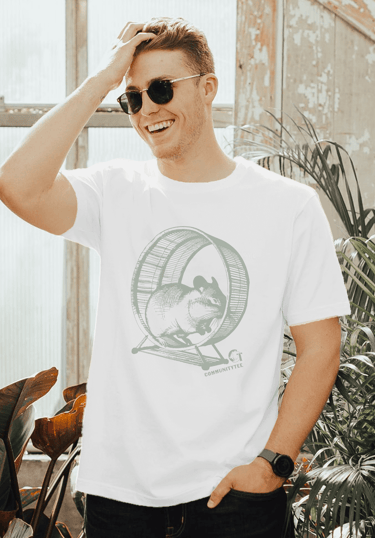Hamster Wheel
Curse and Chance
MOTIVATION
In our last blog, we analyzed that the main reason for envy is a deep-seated dissatisfaction and the resulting uncontrollable emotions. In this blog, I want to analyze one of the triggers for dissatisfaction and show possible ways out. Most who are dissatisfied feel trapped in a hamster wheel they can't escape. This wheel is an endless loop of the same tasks and obligations that keep us in a cycle we can hardly break through. But is this hamster wheel really a trap, and what would breaking out of this wheel look like?
I'm not exaggerating when I say that I've read countless books and studies on how great it is to break out of one's hamster wheel and daily routine to start a new life. Following these tips can, of course, quickly lead to a perceived success, similar to weight loss tips that quickly turn into a yo-yo effect. Initial successes are certainly commendable, but sustainability is missing. In this blog, I aim to show a sustainable way. We live in the illusion of movement, believing we are making progress when we are actually standing still. This realization can be discouraging but also offers a unique opportunity for reflection and reorientation. The desire for change and new challenges is preprogrammed in all of us. Sooner or later, but definitely by the midlife crisis, the longing for "more" catches up with us.
Understanding that we are always in some cycle or wheel and will continue to be is crucial. To be sustainably satisfied, it's not about leaving our wheel, but rather using it to our advantage. If we imagine a hamster wheel and zoom out a bit, we hopefully realize that the wheel is open. Zooming out further, we see that there are many wheels within our reach that we can switch to almost effortlessly. The true art of being content is not in avoiding or destroying wheels but in becoming aware that we have not only the power to choose our wheel but also to adjust, enlarge, or reduce it. Our hamster wheel doesn't have to stand as a symbol of monotony and limitation but can be a tool for creating structure and meaning in our lives. To be content in our self-designed wheel, we must make conscious decisions about how we want to live our daily life. This means setting priorities and creating routines that reflect these priorities. It also means allowing space for flexibility and spontaneous joys to break the monotony and fill our life with moments of joy and satisfaction. A certain daily routine and structures, which the wheel stands for, are not only necessary but also fundamental for our growth and satisfaction. Scientific studies confirm that routines and structures are necessary for our mental health, and therefore, we always need a wheel in our life to be happy.
I know, easier said than done. Why is it so hard for us to implement this? Our tendency to climb back into the same wheels, even if we've had bad experiences in the past, reveals a deeply rooted human tendency. This pattern, particularly noticeable in our relationships where we often choose partners who harm us in similar ways, points to our inclination to prefer the familiar over the unknown. This preference for the familiar partly stems from our deep need for security and predictability. Even if the familiar is harmful, it offers a certain security in the predictability of pain, as opposed to the uncertain fear of the new and unknown.
Psychologically, our early childhood impressions and learned behavior patterns also play a role. Often, we unconsciously repeat patterns that became familiar in childhood, hoping for a different and better outcome this time. This phenomenon, known as the "repetition compulsion," shows our profound longing to heal past injuries by reenacting similar situations, hoping to get it "right" this time.
Ultimately, it's not the hamster wheel itself that limits us, but our narrow-mindedness and fear of change, even when it harms us. Letting go of familiar behavior patterns requires a conscious effort, self-reflection, and often support. Depending on the severity, support can come from one's social environment, like conversations with friends and family. For more serious issues, professional help may be needed. The biggest hurdle to opening up to others is the fear of judgment. Sometimes, it's easier to talk about our thoughts and fears with complete strangers than with our own social circle. Fun fact: By a certain age, everyone will have had the experience of lying on a psychologist's sofa and rating the outcome as "very liberating." I even know a friend of a friend, of the brother of my janitor's hairdresser, who confirmed this to me ;-).
To conclude, Matze's practical tips: There's always a reason why things are the way they are. In the best case, we are just too lazy or comfortable to change them. In the worst case, we fear change and thus harm ourselves. Often, however, it's enough to talk or write about our thoughts, or find another outlet to process them. I use CommunityTee and the blogs as an outlet. The idea behind CommunityTee, as the name suggests, is to build a community, exchange ideas, and support each other in all walks of life. Whether you're looking for advice, want to share your own experiences, or just need to be heard, you're welcome to get in touch with me and Tai, who supports me with this project, and share everything that's on your mind/writing. Anything you share with us will, of course, be treated with discretion!.. stay tuned…
Sources and related links (last visit 16.2.2024):
Northwestern Medicine: Health Benefits of Having a Routine
Psychology Today: The Power of Routines in Your Mental Health
Psychologie Heute: Warum sind wir „verdammt zum Wiederholen“?
PsychCentral: What is Repetition Compulsion?
Medical News Today: What to know about repetition compulsion
Simply Psychology: Repetition Compulsion: Why do we repeat the past?





